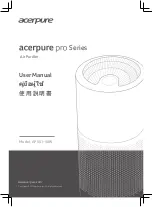
Specialist’s Manual
fire extinguishing equipment shall be available to
hand. Have a dry powder or CO
2
fire extinguisher
adjacent to the charging area.
The following checks shall be applied to instal-
lations using flammable refrigerants:
– the charge size is in accordance with the room size
within which the refrigerant containing parts are in-
stalled;
– the ventilation machinery and outlets are operat-
ing adequately and are not obstructed;
– if an indirect refrigerating circuit is being used, the
secondary circuit shall be checked for the presence
of refrigerant;
– marking to the equipment continues to be visible
and legible. Markings and signs that are illegible shall
be corrected;
– refrigeration pipe or components are installed in a
position where they are unlikely to be exposed to any
substance which may corrode refrigerant contain-
ing components, unless the components are const-
ructed of materials which are inherently resistant to
being corroded or are suitably protected against be-
ing so corroded.
Repair and maintenance to electrical compo-
nents shall include initial safety checks and com-
ponent inspection procedures. If a fault exists
that could compromise safety, then no electrical
supply shall be connected to the circuit until it
is satisfactorily dealt with. If the fault cannot
be corrected immediately but it is necessary
to continue operation, an adequate temporary
solution shall be used. This shall be reported
to the owner of the equipment so all parties are
advised.
●
Initial safety checks shall include:
– that capacitors are discharged: this shall be done
in a safe manner to avoid possibility of sparking;
– that no live electrical components and wiring are
exposed while charging, recovering or purging the
system;
– that there is continuity of earth bonding.
●
Checking for presence of refrigerant
The area shall be checked with an appropriate refri-
gerant detector prior to and during work, to ensure
the technician is aware of potentially toxic or flamm-
able atmospheres. Ensure that the leak detection
equipment being used is suitable for use with all app-
licable refrigerants, i.e. non-sparking, adequately seal-
ed or intrinsically safe.
●
Presence of fire extinguisher
If any hot work is to be conducted on the refrigera-
tion equipment or any associated parts, appropriate
●
●
Ventilated area
Ensure that the area is in the open or that it is ad-
equately ventilated before breaking into the system
or conducting any hot work. A degree of ventilation
shall continue during the period that the work is carri-
ed out. The ventilation should safely disperse any re-
leased refrigerant and preferably expel it externally
into the atmosphere.
●
Checks to the refrigeration equipment
Where electrical components are being changed,
they shall be fit for the purpose and to the correct
specification. At all times the manufacturer's main-
tenance and service guidelines shall be followed. If
in doubt, consult the manufacturer's technical depart-
ment for assistance.
●
Checks to electrical devices
– that capacitors are discharged: this shall be done
in a safe manner to avoid possibility of sparking;
– that no live electrical components and wiring are
exposed while charging, recovering or purging the
system.
●
Repairs to sealed components
During repairs to sealed components, all electrical
supplies shall be disconnected from the equipment
being worked upon prior to any removal of sealed
covers, etc. If it is absolutely necessary to have an
electrical supply to equipment during servicing, then
a permanently operating form of leak detection shall
be located at the most critical point to warn of a
potentially hazardous situation.
Particular attention shall be paid to the following to
ensure that by working on electrical components, the
casing is not altered in such a way that the level of
protection is affected. This shall include damage to
cables, excessive number of connections, terminals
not made to original specification, damage to seals,
incorrect fitting of glands, etc.
– Ensure that the apparatus is mounted securely.
– Ensure that seals or sealing materials have not de-
graded to the point that they no longer serve the pur-
pose of preventing the ingress of flammable atmos-
pheres. Replacement parts shall be in accordance
with the manufacturer’s specifications.
NOTE:The use of silicon sealant can inhibit the
effectiveness of some types of leak detection equi-
pment. Intrinsically safe components do not have to
be isolated prior to working on them.
●
2
2






































